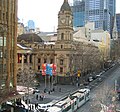History
Joseph Reed, born in 1823 in Cornwall, England, established his firm upon his arrival in Melbourne in 1853, and in 1863, joined with British architect Frederick Barnes, renaming his practice to Reed & Barnes. Their name is linked to many of the major buildings of nineteenth-century Melbourne, [3] including the Melbourne Public Library, Melbourne Town Hall, Rippon Lea, Elsternwick, and Scots Church. [2] The Melbourne International Exhibition building is one of the most notable buildings to be completed by Reed & Barnes. [3]
In 1883 Barnes retired, and A. Henderson and Francis Smart joined Joseph Reed as partners to create Reed, Henderson & Smart. In 1890 Reed died, Henderson withdrew, and William Tappin joined, creating Reed Smart & Tappin. [4] In 1907, N. G. Peebles joined, creating Smart Tappin & Peebles, but with the rapid departure of Tappin, and addition of E. A. Bates, the firm became known as Bates Pebble & Smart the next year. [5] After Peebles died in 1923, the firm became Bates Smart McCutcheon in 1926 when Osborn McCutcheon became a partner; he remained Principal Partner until his retirement. Since 1995 the firm has been known simply as Bates Smart. [6]
The current directors are Matthew Allen, Julian Anderson, Jeffery Copolov, Cian Davis, Mark Healey, Guy Lake, Mathieu le Sueur, Kellie Payne, Brenton Smith, Philip Vivian and Karen Wong.
This page is based on this
Wikipedia article Text is available under the
CC BY-SA 4.0 license; additional terms may apply.
Images, videos and audio are available under their respective licenses.




















